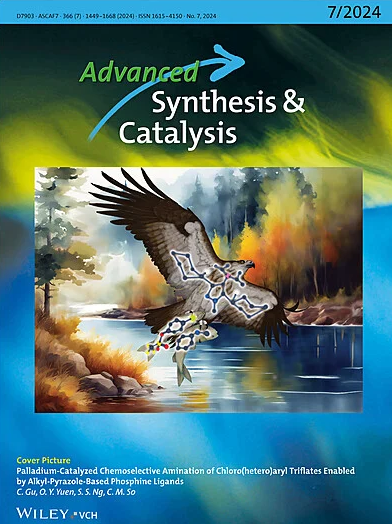Modular Chiral Bithiophene‐2NO Ligands: Synthesis and Application in Asymmetric Palladium(II)‐Catalysed Friedel‐Crafts Alkylation
IF 4.4
2区 化学
Q2 CHEMISTRY, APPLIED
引用次数: 0
Abstract
The development of privileged thiophene‐type ligand remains highly desirable, owing to the high coordination ability of sulfur atom to most of the soft metals. Herein, a new class of C2‐symmetric rigid chiral tertiary amine‐derived dioxide ligands with a coordinating bithiophene bridge was developed in a convenient synthetic route with 25–62% overall yields. The bithiophene‐2NO‐palladium(II) catalyst system was generated in situ and found to be highly capable catalyst in the asymmetric Friedel‐Crafts alkylation of indoles. Excellent yields (up to 92%) and high enantioselectivities (up to >99% ee) are obtained for a wide range of substrates under mild conditions. Control experiments and DFT calculations revealed the origins of the enantioselectivity. This represented the first example of chiral thiophene ligands coordinating with soft metal Pd(II) in the asymmetric Friedel‐Crafts alkylation. Experiments revealed that the counteranion is involved in the stereoselectivity‐determining step in this soft palladium(II) catalysis, and the additional NO and thiophene in ligands can act as the second chelation site and thus reduce the amount of free metal ions for suppressing background reaction in the catalytic system.
模块化手性噻吩-2NO 配体:不对称钯(II)催化的 Friedel-Crafts 烷基化反应中的合成与应用
由于硫原子与大多数软金属的配位能力很强,因此开发具有特权的噻吩类配体仍然非常有必要。在此,我们通过一条简便的合成路线,开发出了一类新的具有配位噻吩桥的 C2 对称刚性手性叔胺衍生二氧化配体,总产率为 25-62%。原位生成的噻吩-2NO-钯(II)催化剂体系在吲哚的不对称 Friedel-Crafts 烷基化反应中具有很强的催化能力。在温和的条件下,该催化剂对多种底物都具有优异的产率(高达 92%)和高对映选择性(高达 99% ee)。对照实验和 DFT 计算揭示了对映体选择性的来源。这是手性噻吩配体与软金属 Pd(II) 在不对称 Friedel-Crafts 烷基化反应中配位的第一个实例。实验表明,在这种软钯(II)催化过程中,反阴离子参与了立体选择性决定步骤,配体中额外的 NO 和噻吩可以作为第二个螯合位点,从而减少游离金属离子的数量,抑制催化体系中的背景反应。
本文章由计算机程序翻译,如有差异,请以英文原文为准。
求助全文
约1分钟内获得全文
求助全文
来源期刊

Advanced Synthesis & Catalysis
化学-应用化学
CiteScore
9.40
自引率
7.40%
发文量
447
审稿时长
1.8 months
期刊介绍:
Advanced Synthesis & Catalysis (ASC) is the leading primary journal in organic, organometallic, and applied chemistry.
The high impact of ASC can be attributed to the unique focus of the journal, which publishes exciting new results from academic and industrial labs on efficient, practical, and environmentally friendly organic synthesis. While homogeneous, heterogeneous, organic, and enzyme catalysis are key technologies to achieve green synthesis, significant contributions to the same goal by synthesis design, reaction techniques, flow chemistry, and continuous processing, multiphase catalysis, green solvents, catalyst immobilization, and recycling, separation science, and process development are also featured in ASC. The Aims and Scope can be found in the Notice to Authors or on the first page of the table of contents in every issue.
 求助内容:
求助内容: 应助结果提醒方式:
应助结果提醒方式:


